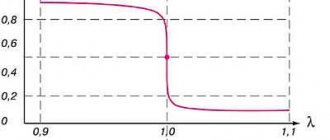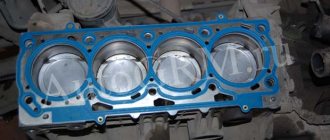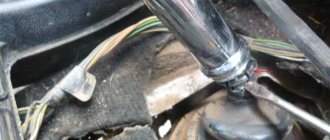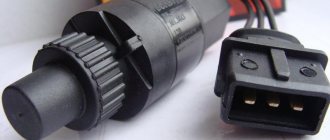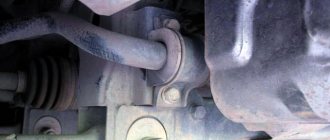Many people wonder how climate control differs from air conditioning, and why climate control costs more than air conditioning. In this article we will try to answer all your questions that may arise when searching for an answer to your main question. Differences between climate control and air conditioning in a car.
First of all, we will outline the differences between air conditioning and climate control; these are completely different mechanisms. Many people confuse this and it is not surprising, because these devices are used for one thing, to make it comfortable to be in the car. When it's hot or cold, we use these devices to cool down or warm up.
Air conditioner
The air conditioner in a car is very different from the air conditioner that is installed indoors. Air conditioners in the room operate from a power outlet, while in the car they operate due to the rotation of the crankshaft via a belt drive. The air conditioner can only cool the air in the cabin. To make it cooler, we increase the fan speed. It is logical that the faster the fan spins, the colder it will be in the cabin. The air conditioner itself cannot heat the air in the cabin; to do this, the heater in the car turns on, and the air conditioner accelerates the air in the cabin.
It is important to know that the air conditioner first takes in air, dries it, and only then does the air cool or heat up.
We recommend viewing. How does air conditioning work?
How does an air conditioner work?
Since its inception, the physical basis of the performance of cooling machines has not undergone significant changes. This is the basis - the ability of substances to absorb or release accumulated heat during the transition from one state of aggregation to another (that is, during evaporation and condensation). The air conditioner is not the only device in the car that works on this principle. The engine cooling system through a radiator is another example where ordinary water was previously used as a coolant, but now antifreeze or antifreeze is used.
Nowadays, air conditioning is a mandatory function and is equipped even in cars with minimal equipment.
In air conditioning units, the coolant is called refrigerant. Currently, these are various brands of freons - special hydrocarbons with the required boiling and condensation points. In addition to the refrigerant, special grades of oil circulate in the cooling circuit. It ensures long-term and uninterrupted operation of rubbing and moving mechanisms. These parts are located mainly in the compressor. Oil and refrigerant are in a mixture state, so if there is a leak, not only does the pressure and efficiency drop, but the safety of the mechanisms also decreases.
Compressor
The most important part that ensures the functionality of the cooling device. It combines two functions. Firstly, it is a pump that ensures that freon, in a liquid or gaseous state, is pumped through all pipelines. Secondly, pressure is created inside the compressor, which thickens the freon vapor coming from the evaporator. Under the influence of pressure, gas turns into liquid with a simultaneous change in temperature characteristics.
General view of the air conditioning compressor
The compressor is driven by power take-off from the crankshaft through a drive belt. When operating an air conditioner, an average of 5 to 15 liters is spent. pp., so if the engine lacks power under load, turning on cold air will only worsen the situation. There is additionally an electromagnetic clutch between the pulley and the compressor rotor - it disconnects the compressor motor when it needs to be turned off.
The compressor performs an important task - it separates the high and low pressure circuits of liquid and gas. The first is called a pressure system, the second is called a suction system.
Capacitor
You may come across the name “condenser”, but this does not change the essence of the matter. It looks like a car radiator and is located there. In the radiator, the freon, condensed in the compressor and thus becoming hot, must cool down. Therefore, manufacturers try to place the capacitor as close to the front edge as possible, behind the radiator grille. Here, the incoming air flow during movement helps in cooling. The condenser also has its own fan, or even a pair of fans - to quickly achieve the effect. True, there is also the other side of the coin. Being in front, the condenser gradually becomes clogged with road dust and dirt, debris, and insects. Over time, this can worsen heat transfer, so the car owner needs to periodically check its condition and clean it mechanically. This will help extend the life of the system and increase the decreased efficiency.
The air conditioning condenser is located in front of the radiator under the hood
Drying filter
This element does not ensure the physics of the cooling process, but contributes to its quality and uninterrupted operation. The fact is that freon accumulates moisture, which has other evaporation and condensation parameters, and therefore interferes with the main function of the air conditioner. In addition, moisture has a more aggressive effect on metal parts and promotes corrosion. Drying the refrigerant returns it to its original state. Well, filtration allows you to remove from the coolant mechanical inclusions that got there during operation - dust, dirt, small debris.
Expansion valve
Its second name is thermostatic valve. The freon coming from the filter drier is supplied in metered portions from the expansion valve to the evaporator. When passing through the valve, the refrigerant changes from a liquid to a gaseous state, but not completely. At this stage, freon is a suspension of gas and fine liquid. You can observe a similar condition when you spray something from an aerosol can. Sometimes a special peephole is installed on the expansion valve to visually monitor the amount of coolant in the system.
Article on the topic: Vacuum brake booster - why is it so easy for us to brake?
The main function of the expansion valve is to relieve internal stress in front of the evaporator, which will lead to its cooling
Evaporator
This is the same radiator, only working in reverse. If in a radiator atmospheric air cools the hot liquid inside, then in the evaporator the incoming cold freon in a gas-liquid state cools the surrounding space. To do this, a fan works in tandem with the evaporator, which drives the cabin air through the evaporator and cools it. Drum-type fan, as in stationary room split systems. The evaporator is usually not very large.
To ensure proper operation of the air conditioner, it is recommended to clean the evaporator at least once every 2-3 years.
Piping and sensor system
The air conditioner wiring is represented by tubes made of copper or copper alloys. They form a freon route from the condenser to the evaporator through the compressor. From the compressor and condenser they are thin and hot, and the return circuit from the evaporator back to the compressor is larger and cold. The air conditioner also includes a moisture collection system, which condenses on the surface of the evaporator. The collected water is drained directly under the bottom of the car. This is the reason for the appearance of puddles under a car in which the air conditioner was running in the parking lot. The cooling device also has several sensors that correlate the operating mode of the air conditioner elements with the specified temperature parameters.
Sequence of work
When you press the button on the instrument panel, the compressor starts. Since the pulley is driven by the rotation of the crankshaft, starting is possible only when the engine is running. The electric coupling connects the pulley to the compressor mechanism, and it begins to drive the refrigerant through the system, simultaneously compressing it. Hot freon enters the condenser, where it not only cools, but also completely turns into a liquid state and condenses. Blowing outside air with a fan and the force of the oncoming flow speeds up this process. The refrigerant passes through a filter drier where it is cleaned and gets rid of moisture. When passing through the expansion valve, the pressure in the system drops sharply, and the liquid becomes an aerosol. As a result of this transition, freon begins to boil, that is, it turns into a gaseous state and becomes cold. Being fed into the evaporator, it lowers its temperature. The air blown through the evaporator by a fan is supplied to the cabin through special ventilation holes. Giving up the cold in the evaporator, freon in a gaseous state goes through the return circuit to the compressor, where the cycle closes. When the desired temperature in the cabin is reached, the sensor sends a signal to turn off the fluid coupling, and the air conditioner “rests” for a while.
The operating principle of a car air conditioner is similar to the operation of a home air conditioner or refrigerator.
Video: how the air conditioner works
Climate control
Climate control is a system that automatically controls and maintains a certain and constant temperature that you set in the settings. There are sensors located throughout the car's interior that read the temperature and humidity of the air in the cabin and transmit all this data to the control unit. Thanks to these sensors, the climate control system understands what needs to be done, whether it needs to be made colder or warmer, in order to maintain the temperature.
Climate control controls all elements using a control unit to maintain a comfortable temperature, including air conditioning. Here is the first difference.
Climate control is a huge plus; you don’t need to be distracted by adjusting the temperature when you’re driving.
Also, the climate control on some cars can even move the air duct dampers itself to make everything even and comfortable.
Dual-zone climate control can make different parts of the car have different temperatures.
What is climate control in a car or apartment?
air circulation diagram in a climate-controlled apartment
Climate control is an intelligent system consisting of a number of different devices to maintain the comfort of the space.
In a car, it ensures human comfort and the absence of fogging of the windows while driving.
The climate control option for an apartment is more complex in terms of equipment. But in both cases, the systems work smoothly all year round without adjustment for weather conditions outside the cabin/walls and outside air temperature.
Setting up air conditioning and climate control
The air conditioning can only be adjusted manually on the central control panel, using buttons or knobs with the snowflake or A/C symbol. You can either turn it on or off, and even increase the power.
Climate control is more complex to control than air conditioning. But it is still just as simple for a person. The button labeled Auto starts the climate control. As soon as the launch occurs, the control unit will immediately collect information from the sensors and analyze the situation in the cabin. And then, using buttons or the same knobs as on an air conditioner, you can set the temperature that the climate control will maintain. In most cars, these devices are controlled this way.
Four-zone option
Yes, four-zone climate control splits the cabin temperature into four zones for each of the four main seats in the car. This type of climate control can be found on high-end luxury cars, mainly limousines, such as the Mercedes S-Class and the most expensive SUVs on sale. However, the four-zone option, like the three-zone systems, will also give the driver the ability to control rear cabin temperature, while all three of these setups will feature a 'sync' button that will set all zones to comfort.
- Author: Olesya Romanova
Rate this article:
- 5
- 4
- 3
- 2
- 1
(1 vote, average: 1 out of 5)
Share with your friends!
Remember about health, how easy it is to get sick using air conditioning and climate control
It is important to remember that you should not lower the temperature too low if it is hot outside, and you should not raise the temperature too high so that it is hot when it is frosty outside. With a sudden change in temperature, you can easily catch a cold.
To be comfortable and safe for your health , set the temperature 5 degrees lower than outside. If you decide to go on a long trip, you can set it even lower, but only every 2 hours and don’t forget to raise it when you get to the place. This way you can protect yourself as much as possible from colds. Take care of yourself and your passengers.
Car air conditioning and health
Of course, we all enjoy sitting in a warm cabin in winter, and hiding from the heat in summer by turning the air conditioning to maximum. But if you use the climate system ineptly, you can seriously harm yourself.
Too much temperature difference between the cabin and outside is an easy way to catch a cold. To avoid problems, experts advise that this difference should be no more than 5 degrees. Of course, if we talk about traveling long distances, this interval can be increased, but this must be done gradually.
Differences between air conditioning and climate control
These are different devices, but the goal is the same. Give you a comfortable ride.
| Air conditioner | Climate control |
| Cheaper both to purchase and to maintain | More expensive both to purchase and to maintain |
| Lower comfort level | Higher level of comfort |
| Easier to manage | More difficult to manage |
| Less convenient to use | More convenient to use |
What is better in a car or apartment: air conditioning or climate control?
apartment room with air conditioning on the wall
The answer depends on a number of factors - the climate zone of residence, the financial capabilities of the owner, and the requirements for the microclimate.
In terms of comfort level of sensations and use, climate control is definitely better. If the main parameter you are focusing on is price, then opt for a good air conditioner.
